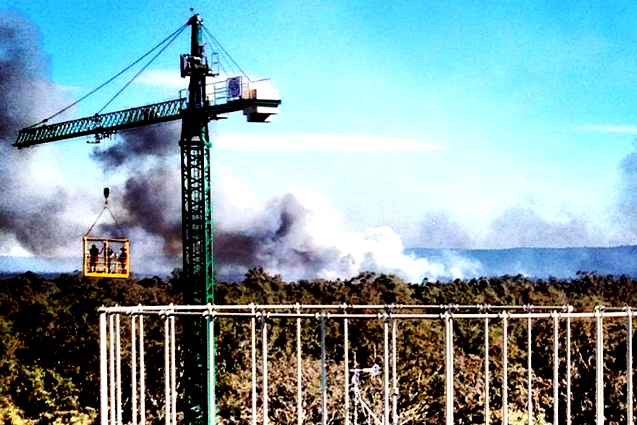 |
| As fires burned, researchers studied how much carbon mature trees could capture and store. Supplied: University of Western Sydney |
Key points
|
At the same time, researchers in New South Wales were finalising a study looking at the capacity for forests to consume and store carbon from the atmosphere.
The results were not comforting.
In fact, they cast doubt over many of the climate models being used to predict carbon levels into the future.
 |
| Professor Belinda Medlyn has published a significant study into the capacity of mature trees to capture and sequester carbon. University of Western Sydney |
In a unique experiment, Professor Belinda Medlyn and her team from Western Sydney University pumped carbon from a commercial supplier into a forest of 90-year-old trees.
They laid pipelines and built tubular structures in the forest to deliver the carbon into the air above the canopy.
They looked at how the trees and the plants in the understory take up the CO2 and found that it passes through the ecosystem in a number of different ways, according to Professor Medlyn.
"Some of the carbon stays in the plants, some of it is eaten by insects, some of it is passed onto symbiotic fungi, some of it goes into the soil where it becomes food for soil micro-organisms."
The results
Their research showed that mature trees could consume an additional 12 per cent of carbon at elevated levels, but that it wasn't sequestered.
"Instead, the majority of the extra carbon was emitted back into the atmosphere via several respiratory fluxes, with increased soil respiration alone accounting for half of the total uptake surplus," Professor Medlyn said.
The explanation, according to Professor Medlyn, was in the soil.
"The soil that they're growing on is fairly poor. It doesn't have a lot of nutrients in it," she said.
"The plants need those nutrients to grow, so it seems what they've done when they've been given extra carbon is just to use that to go looking for extra nutrients."
Implications for global climate models
If mature trees can't store the rising levels of carbon in the atmosphere, then models based on the idea that plants will respond to increased levels of CO2 with extra growth may be wrong.
"At the moment those global calculations assume that mature forests will store will store extra CO2 as concentrations go up, but our results are implying that mature forests can't keep doing that into the future," Professor Medlyn said.
Mature trees also store a lot of carbon, so old forest still need to be protected, said Professor Medlyn.
"They do have a lot of carbon stored in them, it's just they won't keep on taking up more carbon into the future," she said.
CSIRO cautious
 |
| Carbon was piped in from a commercial source and then tubes elevated it above the canopy, raising carbon levels by 38 per cent for the study. University of Western Sydney |
However, he said, more work needed to be done to see if other mature forests responded in the same way, and that two other studies were underway in England and Scotland.
"The big challenge is to begin research across the world to understand if it's common or not common at all," he said.
Links
- 'Like farming underwater': Seagrass nursery could offset carbon emissions
- Pressure ramps up to pull CO2 from the sky with geoengineering tech
- A billion hectares of new trees could pause the climate-change clock
- A billion trees planted by 2030? It can't be done, forestry industry says
- (AU) We Must Fight Climate Change Like It’s World War Iii – Here Are 4 Potent Weapons To Deploy
- (UK) Climate Change: Will Planting Millions Of Trees Really Save The Planet?
- (AU) Ancient Australian Trees Face Uncertain Future Under Climate Change, Study Finds
- Opinion: Current Proposals To Plant Trees To Fight Climate Change Are Badly Misguided
- Examining The Viability Of Planting Trees To Help Mitigate Climate Change

No comments:
Post a Comment